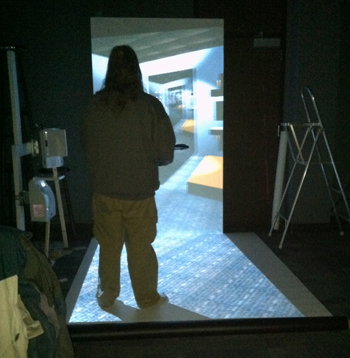Project Overview

The PIs’ goals in this research is to realistically display terrain in an immersive Virtual Reality (VR) locomotion interface, based upon modification of the foot/terrain interaction coupled with graphical and auditory display of the terrain and user interaction. Project outcomes will include novel “smart shoe” technology capable of sensing and modifying the terrain perceived by the wearer at each step so that terrain slope, surface stiffness, height variations, slip and balance can be actively controlled. The approach is based upon an instrumented shoe sole with a directionally compliant structure using controllable bladders and embedded sensors to regulate terrain effects as the user walks. The design and control of the shoe will be based upon dynamic biomechanical and terrain interaction models. Subject data will provide a baseline for design, verification, and validation of the system. A robotic test-bed will validate shoe response characteristics prior to subject evaluations.
The platform for this work will be the existing TreadPort Active Wind Tunnel (TPAWT), which is capable of realistically displaying locomotion environments on varying slopes as well as providing controllable wind, heat, and odor display. The cave-like display of the TPAWT will be converted to a three dimensional stereo graphics system with seamless floor projection in order to present local terrain features such as shape, height variations, and surface texture. Combined representation, interpretation, and coordination of the graphical and physical artifacts will be considered with the aim of creating an immersive and realistic locomotion experience with the end goal of achieving practical application. This combined system is termed the TPAWT Terrain Display System (TPAWT-TDS).
The target test group for the new technology will be patients with Parkinson’s Disease, (PD), for whom VR training has already shown some promising results for improving gait characteristics and reducing the likelihood of falls. Survey data from PD patients will motivate selection of the specific terrain. Regular and PD users will first be evaluated on physical mockups of the terrain, which will then be recreated and evaluated in follow-up trials in the VR environment. Once validated, the VR terrain display will be used for PD training. Users will again be evaluated on the physical mockups to evaluate gait and balance performance, which will also be compared to untrained subjects.
Broader Impacts: The “smart shoe” technology to be created in this project will allow exploration of new and sophisticated methods for combining 3D graphical terrain cues with an actively changing physical terrain in a novel VR interface. The resulting environment will have myriad potential applications as a rehabilitation and training tool, not the least of which is improved locomotion and fall prevention (since falls are the single most costly form of injury today). Development of the new technology will be combined with rigorous human participant studies. Research findings will be disseminated via websites and at major conferences, and also integrated into the robotics, virtual reality, ergonomics, and physical therapy curricula.
Recent Updates
Funding Source
This material is based upon work supported by the National Science Foundation under Grants No. IIS-1162131 and IIS-1162617 (Utah). Any opinions, findings, and conclusions or recommendations expressed in this material are those of the author(s) and do not necessarily reflect the views of the National Science Foundation.
- NSF Award: 1162131. 10/01/2012-09/30/2016. HCC: Medium: Collaborative Research: Haptic Display of Terrain Characteristics and its Application in Virtual and Physical Worlds.
Collaborators
The project is supported by the National Science Foundation and is a highly collaborative project including colleagues from the University of Utah and the University of Minnesota Duluth.